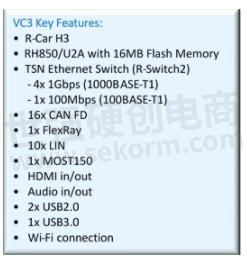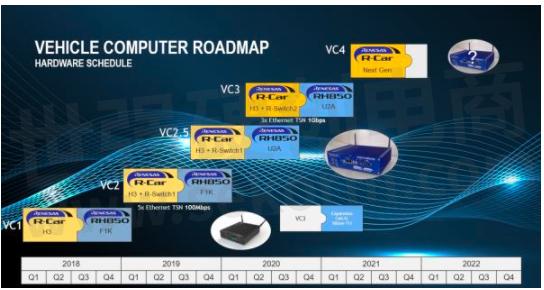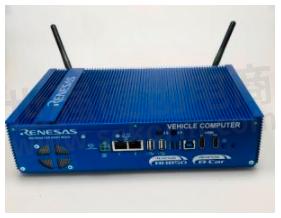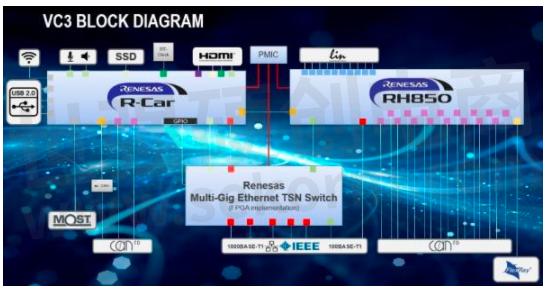VC3: Evaluation System for New E/E Architecture Combining Digital and Analog Semiconductors

Just as fossil fuels drove the industrial revolution, data provides the fuel for the information economy and so many modern technical innovations. Data is everywhere but, just as with oil, it is of little use until it is moved from its source to be processed. Without the right pipeline and a distribution network, the true value of the resource cannot be unlocked. While the pipeline may often be overlooked or underappreciated, it is a vital part of the larger system. In vehicle electronics, the pipeline's part is played by robust, reliable data networks.
Since the introduction of networking into automotive systems, the volume of data travelling across these networks has skyrocketed. Driver assistance systems bring ever higher levels of comfort and safety. In-vehicle entertainment begins to rival the cinema experience. These and many other local and remote features and services bring immense quantities of data into the computers we formerly knew as cars.
To cope with this traffic, suitable infrastructure is required. Traditionally, vehicles have hosted several different types of networks, some of which cannot be easily replaced. For both commercial and technical reasons, some legacy systems will remain in new vehicle designs far into the future. However, even decades ago, there was a strong push to replace existing proprietary and standards-based protocols with a single, new protocol: CAN. Since then, CAN has become ubiquitous in automotive systems, but a new crop of other protocols has grown up to fill specific needs, and the reality in today's vehicles is again a mix of network protocols, from LIN, CAN, and CAN FD to FlexRay, MOST, and more.
The dream of a homogeneous network infrastructure inside the car is not new, but the recent introduction of Ethernet into vehicles has served to reawaken the hope for a single-bus system, this time using only IP communication. With its wide spectrum of data rates (from 10Mbps to 10Gbps today) and newly-minted Time-Sensitive Networking (TSN) standards for greater Quality-of-Service (QoS) configuration flexibility, Automotive Ethernet may get us a step closer to the dream of protocol consolidation.
There are commercial barriers to changing and to upgrading systems to Ethernet. For traditional car companies, as long as it is not technically necessary to modify existing electronics to add or change features, older electronic control unit (ECU) designs carry over from one vehicle generation to the next. A mix of several bus systems even occurs in “clean slate” architectures with no legacy systems to consider, such as those from companies like Tesla. In both cases, network gateways are required to bridge among different bus technologies and to transform data from one protocol to another. This bridging concept will continue even as the variety of different network types begins to diminish.
In the future, these gateway ECUs will have new challenges. Past gateways bridged communication among CAN and CAN FD, LIN, and FlexRay. Data rates for these protocols range from 20kbps to 10Mbps, with levels of event frequency and data throughput that can be handled by current real-time processors such as the RH850/F1Kx family of microcontrollers (MCUs) from Renesas. With Ethernet, however, the explosion of data throughput is measured in orders of magnitude, with bit rates climbing up to 10Gbps and frame lengths expanding from only 10’s of bytes toward 1000’s of bytes. At the same time, the need to connect to the lower-speed legacy protocols requires not only protocol conversion, but even data conversion in the background. Renesas is addressing these challenges with new processor device concepts and integrated hardware acceleration.
To create and evaluate advanced vehicle gateway systems, Renesas has developed a multi-protocol gateway evaluation kit, called Vehicle Computer, which is already in its 3rd generation.
Picture 1: Vehicle Computer Roadmap
The first version was developed with our partner CETITEC GmbH and promotes a gateway solution consisting of an R-Car H3 System on a Chip (SoC) combined with an RH850/F1KH-D8 MCU. The latest generation, including a proprietary Ethernet switch, was developed by Renesas alone. This version, called Vehicle Computer 3 or VC3, consists of the same R-Car H3, the R-Switch2 Ethernet switch developed by Renesas, and an RH850/U2A MCU. The chip set is rounded out with a combination of digital and analog semiconductors drawn from the portfolios of companies recently acquired by Renesas.
The development roadmap above illustrates the quick progression of automotive networking technology at the moment. The first version of the vehicle computer was equipped with only 8 CAN FD channels and support for 100Mbps Ethernet, supporting the Audio Video Bridging (AVB) standards from IEEE. The new generation expands the CAN FD channel count to 16, with 3 x 1000BASE-T1 Gigabit Ethernet interfaces connected to an Ethernet switch that supports the newer TSN standards. In addition, another Gigabit Ethernet interface supports AVB, and an Ethernet debug interface simplifies debugging and software development.
Picture 2: VC3 in a robust housing
The VC3 supports the entire range of common automotive interfaces, from LIN up to high-speed specialized interfaces like FlexRay and MOST. The range of potential use as a prototyping platform is extended by other supported interfaces, including audio, video (HDMI), USB, and even Wi-Fi. While this lends a great deal of flexibility and increases the usability, the primary target use-case is the evaluation of network strategies for new electrical/electronic (E/E) architectures for future vehicle generations. With a powerful SoC from the R-Car family, combined with the state-of-the-art real-time RH850/U2A MCU, with 16MB of flash memory, there is plenty of processing power to support the many communication channels.

Table 1: Key features of the Vehicle Computer multi-protocol gateway
From an Ethernet standpoint, the heart of the system is the R-Switch2, an Ethernet switch and routing engine developed by Renesas. It provides a nonblocking store/forward architecture with QoS enhancements, all according to the latest TSN standards from IEEE. The integrated forwarding engine includes VLAN support as well as forwarding and filter functions up to L2-L4 routing. This allows the switch to be configured as fully autonomous IPv4/IPv6 router.
Picture 3: VC3 Block diagram
With the 3 major ingredients, R-Car H3 SoC, RH850/U2A MCU, and the R-Switch2, the VC3 architecture represents a high-end vehicle gateway platform. The SoC covers performance-hungry application services while the MCU handles real-time domain applications and safety-relevant traffic. In addition to enabling vehicle architecture evaluation and general proof-of-concept development, the VC3 gives early customers the opportunity to evaluate gateway system performance and to develop system software ahead of silicon availability for next-generation Renesas R-Car devices supporting this specific use-case.
The VC3 is available in sample quantities, with first shipments to customers in August 2020. From early 2021, larger quantities will be available. The evaluation system targets network developers at car manufacturers and Tier1 automotive suppliers, to assist in the definition of E/E architectures for next-generation vehicles.
Please visit our website for more technical detail about the Renesas multi-protocol gateway solution for all major Automotive communication interfaces, including Ethernet TSN. Related R-Car SoC and RH850 MCU documentation can be found there as well.
- +1 Like
- Add to Favorites
Recommend
- Easy-to-Start Automotive MCU Accelerates the Development Cycle
- Renesas RH850 Series Contributes to the Realization of a Flying Motorcycle
- Renesas and FAW Establish Joint Laboratory to Accelerate Development of Next-Generation Smart Vehicles
- Renesas MCUs Can Rewrite The Update Software by Wireless Communication with OTA Technology
- Renesas RH850/C1M-Ax MCU Solves Complex Control Challenge in Integrated Dual Traction Inverter
- Renesas R-Car SoC and RH850 MCU to be Used in Honda SENSING System
- Renesas Expands Lineup of 28nm Cross-Domain Automotive Control Microcontrollers
- Silicon Labs Expands MCU Platform with a 50MHz Core Frequency New BB5 8-bit MCU Family
This document is provided by Sekorm Platform for VIP exclusive service. The copyright is owned by Sekorm. Without authorization, any medias, websites or individual are not allowed to reprint. When authorizing the reprint, the link of www.sekorm.com must be indicated.
































































































































































































































































































































































































































































































































































































































































































































































































































































































